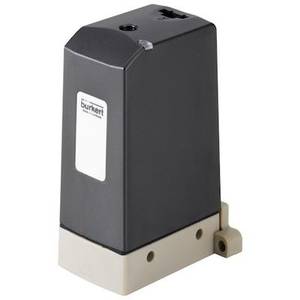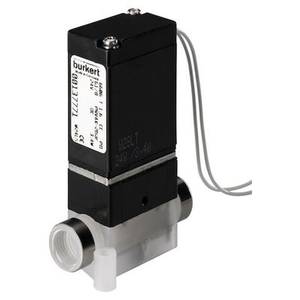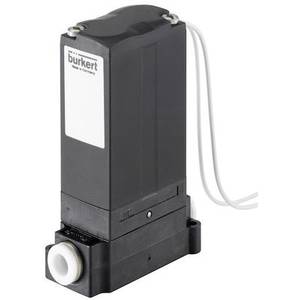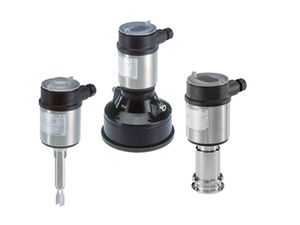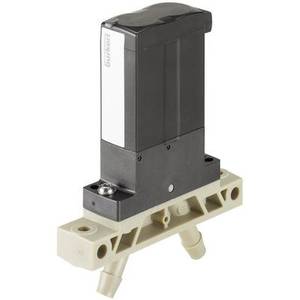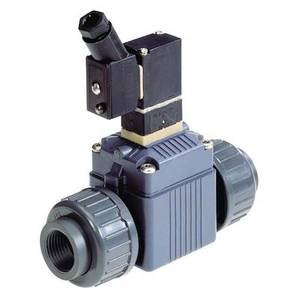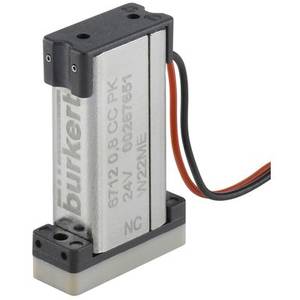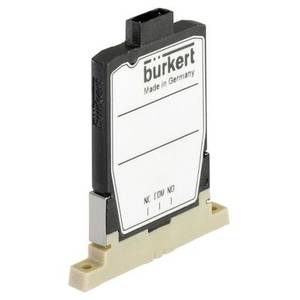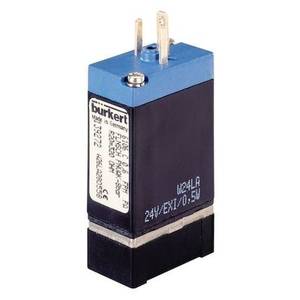Burkert Microfluidic Valves
Micro dosing unit
- separating diaphragm. 2/2-way
- 16 mm analysis
- Solenoid valve with medium separation
- 22 mm ultra compact design
2/2-way-solenoid valve, servo assisted
Flipper Solenoid Valve with separating diaphragm 4,5 mm
Burkert Microfluidic Valves and Pumps
Burkert is a German company founded in 1946 that develops and manufactures fluid management systems and instrumentation. The company offers a wide range of high-quality products including valves, sensors, controllers, and complete fluid handling systems. In particular, Burkert produces microfluidic flow control devices. So, today we are going to talk about their microfluidic solutions in more detail.
What Are Microfluidic Valves and Pumps?
Microfluidic valves, also called microvalves, are the main components used in microfluidic devices to deliver liquids through various valve orifices. Burkert microfluidic valves help control the flow of small volumes of fluid. This control allows microfluidic devices to become more complex and more automated depending on the needs of the application. For example, in medical and diagnostic settings, these valves control the flow of neutral and corrosive fluids such as blood or chemicals. The valves can be easily integrated into the system and controlled in real-time, even without the need for a PC.
Applications of Microfluidic Valves and Pumps
Burkert microfluidic pumps and valves play a crucial role in various applications due to their ability to precisely control and manipulate small volumes of fluids. Here are some key microfluidic valve applications.
Lab-on-a-chip devices
Microfluidic systems (pumps pipes and valves) are often used for miniaturized lab-on-a-chip devices, enabling point-of-care diagnostics, DNA analysis, and medical testing.
Drug delivery systems
These pumps can be employed for controlled drug delivery, ensuring precise dosing and release of pharmaceutical compounds.
Chemical synthesis
Such systems are used for chemical synthesis, allowing for precise control over reaction conditions and the production of small quantities of chemicals.
Protein analysis
Microfluidics is applied in protein separation, purification, and analysis for research and pharmaceutical development.
Water quality analysis
These devices can be used for on-site water quality monitoring, detecting contaminants, and analyzing environmental samples.
Organic synthesis
Microfluidic devices serve as microreactors for organic synthesis, providing controlled conditions for chemical reactions with small reagent volumes.
Cell studies
Such equipment enables the cultivation and study of cells in controlled microenvironments, facilitating cell biology research and drug screening.
3D printing
These valves and pumps can be used in 3D printing applications, especially in the field of bioprinting for creating tissue scaffolds and organoids.
Diagnostic devices
Microfluidic technologies are used in portable and rapid diagnostic devices for applications such as blood glucose monitoring and infectious disease detection.
Mass spectrometry and chromatography
Microfluidic systems can be integrated with analytical techniques like mass spectrometry and chromatography for efficient and high-throughput chemical analysis.
Photonics applications
Such valves and pumps are integrated with optical components in optofluidic devices, enabling applications in sensing, imaging, and telecommunications.
Nanoparticle synthesis
These devices are utilized for the synthesis of nanoparticles with controlled size and properties for applications in materials science and drug delivery.
Burkert's Microfluidic Valve Technology
Microfluidic valve technology plays a crucial role in the field of microfluidics, which involves the manipulation and control of small volumes of fluids, typically at the microliter or nanoliter scale. Microfluidic valves serve as key components in microfluidic systems, providing precise control over the flow of liquids in various applications.
These devices are designed to control the flow of fluids through microchannels. They can be actuated using various mechanisms, including mechanical, pneumatic, magnetic, or electrostatic methods. The choice of actuation method depends on the specific requirements of the application.
Advantages of Burkert Microfluidic Valves and Pumps
Burkert is renowned for producing high-quality fluid monitoring and control products. Every device produced by the company meets the highest quality standards. Let's take a look at the benefits you get with Burkert fluidic systems.
Precision and accuracy
Burkert precision fluid control technology is designed to provide precise control over fluid flow, ensuring accurate dosing and mixing in microscale applications.
Compact design
Microfluidic systems often require compact components, and Burkert's products are typically designed with a small footprint, making them suitable for integration into tight spaces and microfluidic platforms.
Fast response times
Burkert's microfluidic valves and pumps are engineered to have fast response times, allowing for rapid changes in fluid flow and enabling dynamic control in applications where timing is critical.
Reliability and consistency
Burkert is known for producing reliable and consistent pumps and valves. Microfluidic systems demand stable performance, and Burkert's valves and pumps are likely designed to meet these requirements.
Versatility
Microfluidic solutions may be versatile and compatible with a wide range of fluids, including corrosive or sensitive substances, allowing for broad applicability in various industries.
Integration capabilities
Such microfluidic components are designed for easy integration into larger systems, enabling seamless incorporation into diverse applications such as lab-on-a-chip devices, analytical instruments, and medical devices.
Materials and manufacturing quality
Burkert is known for maintaining high standards of manufacturing quality. The materials used in their microfluidic valves and pumps are likely chosen for durability, chemical resistance, and suitability for microscale applications.
Customization options
Depending on the product line, Burkert may offer customization options to meet specific application requirements, allowing users to tailor their microfluidic systems to unique needs.
Application expertise
Burkert's extensive experience in fluid control systems means that their microfluidic valves and pumps are likely developed with a deep understanding of the applications and industries they serve.
Choosing the Right Microfluidic Valve or Pump
Choosing the right Burkert microfluidic valves and pumps depends on several factors, including the specific requirements of your application. Here are some key considerations to help guide your selection process.
Fluid compatibility
Identify the type of fluids you will be working with. Ensure that the materials used in the valve are compatible with the properties of the fluids (e.g., corrosiveness, viscosity).
Flow rate and pressure
Determine the required flow rate and pressure for your application. Different microfluidic valves may have varying capacities, so choose one that meets the performance specifications of your system.
Valve type
Burkert offers various types of microfluidic valves, including solenoid valves, pneumatic valves, and more. Choose a valve type that suits your application's requirements for control, response time, and precision.
Control mechanism
Consider the control mechanism needed for your application. Burkert microfluidic valves may be controlled manually, electrically (solenoid actuation), or pneumatically. Select the control method that aligns with your system's requirements.
Size and integration
Evaluate the physical size and integration capabilities of the valve. Ensure that it fits within the spatial constraints of your microfluidic system and can be easily integrated into your setup.
Response time
Some applications require fast response times. Consider the valve's response time and choose one that meets the dynamic control needs of your system.
Temperature range
Check the temperature range within which the valve can operate effectively. Ensure that it can handle the temperature conditions present in your application.
Customization options
If your application has specific requirements that standard valves may not meet, check if Burkert offers customization options. Some manufacturers provide tailored solutions based on customer needs.
Environmental conditions
Consider the environmental conditions in which the valve will operate. Ensure that the valve is suitable for ambient conditions such as humidity, pressure, and chemical exposure.
Regulatory compliance
Ensure that the chosen microfluidic pumps comply with relevant industry standards and regulations, especially if they will be used in applications with specific certification requirements (e.g., medical devices).
Documentation and support
Review the product documentation provided by Burkert, including technical specifications and user manuals. Additionally, consider the availability of customer support or technical assistance from Burkert.
Burkert's Commitment to Quality
Burkert is a company known for its commitment to quality in the design and manufacturing of microfluidic pump solutions, including microfluidic valves. Burkert traditionally emphasizes several aspects of quality commitment that we’ll consider below.
ISO certifications
Burkert holds ISO certifications, such as ISO 9001, which signifies adherence to international quality management standards. These certifications demonstrate the company's commitment to maintaining consistent and high-quality manufacturing processes.
Quality management system
Burkert implements a robust quality management system to ensure that its products meet or exceed industry standards. This involves comprehensive processes for design, manufacturing, testing, and quality control.
Material selection
Burkert is likely to prioritize the use of high-quality materials in the construction of its valves. The selection of materials is crucial for ensuring durability, resistance to corrosion, and compatibility with a variety of fluids.
Testing and validation
Burkert conducts rigorous testing and validation procedures on its products to ensure they meet specified performance criteria. This includes functional testing, endurance testing, and other quality assurance measures.
Continuous improvement
A commitment to quality often involves a culture of continuous improvement. Burkert regularly reviews and enhances its processes, technologies, and product designs to incorporate the latest advancements and address customer feedback.
Compliance with regulations
Burkert typically adheres to relevant industry regulations and standards. This is particularly important in industries such as healthcare and pharmaceuticals, where strict compliance is required.
Customer Satisfaction
Burkert places importance on customer satisfaction by delivering reliable products that meet or exceed customer expectations. Customer feedback is often considered in the company's continuous improvement efforts.
Environmental responsibility
Companies with a commitment to quality often extend that commitment to environmental responsibility. Burkert implements eco-friendly practices in its manufacturing processes and materials selection.
